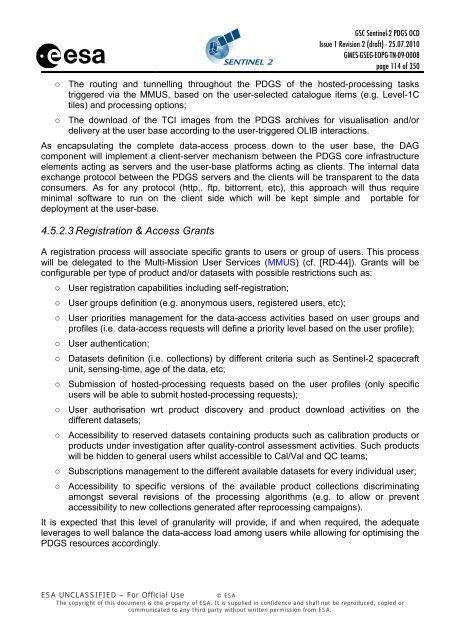GSC Sentinel-2 PDGS OCD - Emits - ESA
GSC Sentinel-2 PDGS OCD - Emits - ESA
GSC Sentinel-2 PDGS OCD - Emits - ESA
You also want an ePaper? Increase the reach of your titles
YUMPU automatically turns print PDFs into web optimized ePapers that Google loves.
<strong>GSC</strong> <strong>Sentinel</strong>-2 <strong>PDGS</strong> <strong>OCD</strong><br />
Issue 1 Revision 2 (draft) - 25.07.2010<br />
GMES-GSEG-EOPG-TN-09-0008<br />
page 114 of 350<br />
○ The routing and tunnelling throughout the <strong>PDGS</strong> of the hosted-processing tasks<br />
triggered via the MMUS, based on the user-selected catalogue items (e.g. Level-1C<br />
tiles) and processing options;<br />
○ The download of the TCI images from the <strong>PDGS</strong> archives for visualisation and/or<br />
delivery at the user base according to the user-triggered OLIB interactions.<br />
As encapsulating the complete data-access process down to the user base, the DAG<br />
component will implement a client-server mechanism between the <strong>PDGS</strong> core infrastructure<br />
elements acting as servers and the user-base platforms acting as clients. The internal data<br />
exchange protocol between the <strong>PDGS</strong> servers and the clients will be transparent to the data<br />
consumers. As for any protocol (http,. ftp, bittorrent, etc), this approach will thus require<br />
minimal software to run on the client side which will be kept simple and portable for<br />
deployment at the user-base.<br />
4.5.2.3 Registration & Access Grants<br />
A registration process will associate specific grants to users or group of users. This process<br />
will be delegated to the Multi-Mission User Services (MMUS) (cf. [RD-44]). Grants will be<br />
configurable per type of product and/or datasets with possible restrictions such as:<br />
○ User registration capabilities including self-registration;<br />
○ User groups definition (e.g. anonymous users, registered users, etc);<br />
○ User priorities management for the data-access activities based on user groups and<br />
profiles (i.e. data-access requests will define a priority level based on the user profile);<br />
○ User authentication;<br />
○ Datasets definition (i.e. collections) by different criteria such as <strong>Sentinel</strong>-2 spacecraft<br />
unit, sensing-time, age of the data, etc;<br />
○ Submission of hosted-processing requests based on the user profiles (only specific<br />
users will be able to submit hosted-processing requests);<br />
○ User authorisation wrt product discovery and product download activities on the<br />
different datasets;<br />
○ Accessibility to reserved datasets containing products such as calibration products or<br />
products under investigation after quality-control assessment activities. Such products<br />
will be hidden to general users whilst accessible to Cal/Val and QC teams;<br />
○ Subscriptions management to the different available datasets for every individual user;<br />
○ Accessibility to specific versions of the available product collections discriminating<br />
amongst several revisions of the processing algorithms (e.g. to allow or prevent<br />
accessibility to new collections generated after reprocessing campaigns).<br />
It is expected that this level of granularity will provide, if and when required, the adequate<br />
leverages to well balance the data-access load among users while allowing for optimising the<br />
<strong>PDGS</strong> resources accordingly.<br />
<strong>ESA</strong> UNCLASSIFIED – For Official Use<br />
© <strong>ESA</strong><br />
The copyright of this document is the property of <strong>ESA</strong>. It is supplied in confidence and shall not be reproduced, copied or<br />
communicated to any third party without written permission from <strong>ESA</strong>.

















